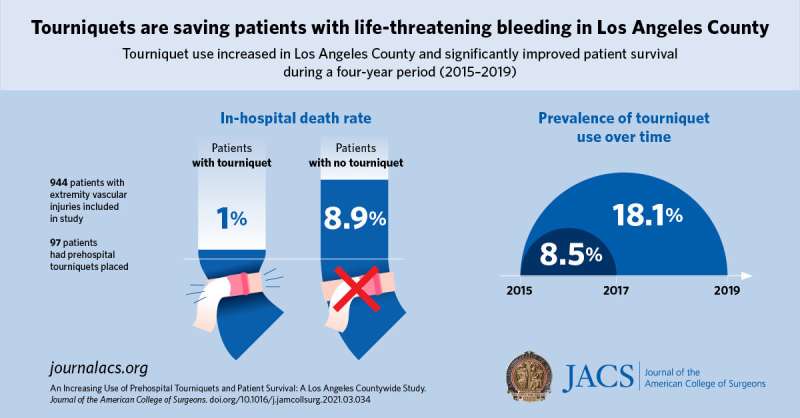Increased tourniquet use has saved lives in Los Angeles County

Uncontrolled bleeding continues to be one of the most common causes of preventable death from a traumatic injury. However, patient survival from such injuries has improved in Los Angeles County due to an increased use of tourniquets to help stop severe bleeding before a patient arrives at a hospital. Findings appear in a Journal of the American College of Surgeons study published online in advance of print.
Researchers from the University of Southern California, Los Angeles set out to determine whether tourniquet use was increasing over time at the local level, specifically in Los Angeles County, and whether the use of tourniquets to control bleeding before a patient arrives at a hospital is associated with improved patient outcomes without complications. This study is believed to be the first of its kind, capturing tourniquet use data for an entire region, according to the authors."In Los Angeles County, the use of prehospital tourniquets for patients with extremity vascular injuries is increasing," the researchers concluded. "Its use is significantly associated with improved survival and a decreased blood transfusion requirement, without an increased risk of delayed amputation."Tourniquets have previously been used more in the armed forces, but have become increasingly accepted in civilian life in recent years due to their effectiveness at reducing death after an injury. Although tourniquets had once fallen out of favor over concerns of complications, recent studies have shown they are largely safe with proper surgical care after arriving at the hospital. "What appears consistent across recent studies is that tourniquet use does not appear to be associated with an increased risk of delayed amputation, even with tourniquet times of over two hours," the authors note.
The researchers conducted a retrospective study from October 2015 to July 2019, including 944 patients in the study, 97 of which had a prehospital tourniquet placed before arriving at the hospital. Data on tourniquet placement by an EMS provider or a member of the public were not captured. Data were pulled from the Emergency Medical Services (EMS) provider registry and the trauma registry of the Los Angeles County Department of Health Services (LAC-DHS) EMS Agency. The patients included were trauma patients who were transported by EMS to one of the 15 Level I or Level II trauma centers in Los Angeles County.The researchers compared two groups in the study, those with a prehospital tourniquet (PHTQ) placed with those who had no-tourniquet (no-PHTQ) placed. The average hospital length of stay, intensive care unit (ICU) length of stay, and delayed amputation rates were similar for both groups. Key differences include the following:
- In-hospital mortality was significantly higher in the no-PHTQ group (1 percent for PHTQ vs 8.9 percent for no-PHTQ)
- Prehospital tourniquet use was significantly associated with lower blood transfusion requirements at four hours and 24 hours (1 liter of blood needed at four hours and 2.5 liters at 24 hours for non-tourniquet patients and about a half-liter and one liter, respectively, for tourniquet patients)
"A higher number of tourniquets placed was associated with improved mortality and decreased requirements for transfusions and no difference in the rate of amputations," said lead study author Reynold Henry, MD, MPH, general surgery chief resident at LAC+USC Medical Center.
Importance of trauma center access
Although the researchers found a significant relationship between the use of tourniquets and an improvement in patient survival, they noted these findings are specific to Los Angeles County, where access to a trauma center is much more readily available than many rural areas in the U.S."The average transport time to a trauma center in Los Angeles County is around 10 to 15 minutes, which is quite short compared to other areas of the country, especially rural areas," said Kazuhide Matsushima, MD, FACS, assistant professor of surgery in the division of acute care surgery, LAC+USC Medical Center.

STOP THE BLEED saves livesOne of the factors behind the increase in prehospital tourniquet use is STOP THE BLEED, a public awareness campaign aimed at empowering the public by teaching bleeding control techniques—applying a tourniquet, applying pressure, or packing a wound—in communities across the U.S. and around the world. Dr. Henry and Dr. Matsushima stressed the importance of widespread tourniquet availability and public knowledge of bleeding control techniques. By knowing how to control bleeding, members of the public can become empowered to save a life."We'd like to encourage the public to think about this as a very simple intervention that anyone can do after a very simple training. Anyone can save a life," said Dr. Matsushima.An important aspect of spreading this knowledge is governmental legislation that enhances the reach and lifesaving ability of STOP THE BLEED."On a local, state, and federal level, policy needs to reflect that getting tourniquets into public spaces and mandatory STOP THE BLEED training for certain types of jobs can go a long way. That is something we, as surgeons, should be advocating for," Dr. Henry said.
More information: Reynold Henry et al. Increased Use of Prehospital Tourniquet and Patient Survival: Los Angeles Countywide Study, Journal of the American College of Surgeons (2021). DOI: 10.1016/j.jamcollsurg.2021.03.023

















